
![]()
Intelligence Research Observatory
Scouting Hypersonics, An Intelligence Primer
Research & Analysis-S.A. Cavanagh
Background and Analysis
Hypersonic Vehicles are ordinance transport systems capable of delivering nuclear, biological & conventional warheads. Hypersonics are capable of speeds between Mach 5 and Mach 27, this is too fast for any defense system to follow & neutralize. In addition to speed, Hypersonics are agile and maneuverable; they do not follow the traditional missile parabolic path and are difficult to monitor as a result. Hypersonic weapons fly too high for established anti-aircraft defenses, and travel at altitudes too low for current anti-ballistic missile defenses. To précis, Hypersonics are too fast, too maneuverable and fly in a range of altitudes that is impractical to track & shoot down. Hypersonics will change every aspect of how warfare is conducted. There is no longer mutual assured destruction, and the most appropriate way of countering adversaries with hypersonic armaments, is have more of them in the arsenal. The nation with the most hypersonics assures more of their ordinances will penetrate the rivals infrastructure and military apparatus. A new arms race has emerged; bringing with it “warhead ambiguity,” this means that it is not clear to adversaries if the weapons are nuclear-armed or armed with conventional payloads; which may perhaps result in unintended nuclear war. The Peoples Liberation Army of China has invested heavily in hypersonic vehicles and is likely ready to deploy its weapons in the offing. Russia has no less then 3 operating hypersonic vehicles in the pipeline, and has deployed first generation hypersonics into the motherlands southern military districts. The United States is following in the wake of Russia and China with hypersonic programs, and is investing billions in research and development. The USA is likely ready to field high quality hypersonics. Additional nations pursuing hypersonic ordinance delivery vehicles include; Israel, the United Arab Emirates, France, Japan, the United Kingdom, and Australia. India has successfully tested hypersonics in 2020, and is ready to deploy naval hypersonic missiles, as deterrence for Chinese presence in the Indian Ocean. The United States is working with Israel and Australia to develop joint hypersonic systems. The UK announced it will acquire hypersonic technology off the shelf from an ally or work with another nation to develop its own hypersonic arsenal. Australia is going all in with hypersonic weapons as it lives in the regional shadow of Chinese power and influence. Hypersonic vehicles will be launched from submarines, surface vessels, fighter-bomber airframes, drones, ballistic missile silos and mobile platforms such as trucks. In the future multiple roles will be performed by hypersonic vehicles, in particular intelligence, surveillance and reconnaissance. China already claims to have hypersonic reconnaissance capability. Most interestingly the United States Department of Defense has contracted SpaceX & L3 Harris to develop a prototype satellite system based on the SpaceX Starlink Constellation to defend against hypersonic attacks. Japan is considering similar low earth orbit satellite constellations as well. Hypersonics will be the future of nuclear and conventional warfare; concurrently hypersonics is fueling the latest arms race and cold war.
Hypersonics in a Nutshell
Synopsis from prominent Physicist Louis A. Del Monte BSc, MSc, author of War at the Speed of Light,
- Hypersonic missiles (hypersonic Vehicles) are missiles which can fly at more then 5 times the speed of sound, travel lower in the atmosphere then current nuclear tipped ballistic missiles, and maneuver during flight
- Hypersonic missiles pose a threat to the doctrine of “Mutual Assured Destruction” in that they will allow a nation to strike an adversary in a matter of minutes
- Their low trajectory will enable them to travel farther and more stealthily than other missiles
- Hypersonics maneuverability allows them to evade an adversaries missile defenses
- If any other state produces these missiles in large quantities, it could destroy another states nuclear arsenal before the victim has a chance to respond (Del Monte, 2021)
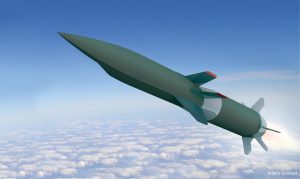
Photo Courtesy of DARPA (2020)
What are Hypersonic Vehicles?
- The general term of “hypersonic weapons” here refers to aircraft, missiles (other than ballistic missiles), rockets, and spacecraft that can reach speeds through the atmosphere faster than Mach 5, that is, nearly 4,000 miles per hour (FINABEL-European Army Interoperability Centre, 2020)
- Technically, far-flying nuclear-tipped ballistic missiles that arc into space have already been travelling at hypersonic speeds for over 60 years (FINABEL-European Army Interoperability Centre, 2020) (Defense-Aerospace.com, 2019)
What About Hypersonic Ordinance?
- Open source intelligence indicates that; hypersonic payloads will include the same warhead technology seen in current conventional, biological & nuclear warhead standard ordinance
What about Other Hypersonic Payloads?
De Faakto Hypersonic Mission & Payload Forecast,
- Clearly hypersonic vehicles are a platform and as technology improves, other mission payloads will develop
- Examples may include, pods for laser strikes, dumb kinetic projectiles dropped from passing overhead hypersonic vehicles, and hypersonic reconnaissance flights that can capture images of targets similar to missions the SR-71 Blackbird airframe performed
- Hypersonics are a concept that can do anything conventional aircraft, spacecraft and rockets already do; hypersonics will simply do it faster, be more maneuverable and challenging to counteract
How Do Hypersonics Work?
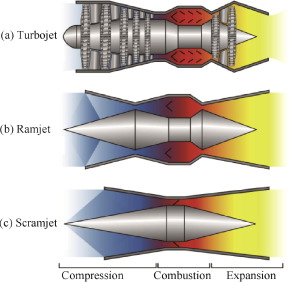
Photo Courtesy of Science Direct (2018)
Ramjet Technology
- Ramjets are a type of jet engine that is mechanically simple but needs to be travelling at about the speed of sound to start producing thrust
- For this reason they need a launch booster to get them up to speed (Forbes, 2020)
Scramjet Technology
- Scramjet hypersonic Missiles will be flying at speeds in excess of Mach 6 (twice as fast as the ramjet)
- They do this by using a scramjet, which stands for supersonic combustion ramjet
- This is even simpler than a ramjet but needs to be going even faster to work (Forbes, 2020)
How are Hypersonics Deployed?
- Hypersonic missiles can be launched from an Intercontinental Ballistic Missile (ICBM) or Submarine-Launched Ballistic Missile (SLBM), after which the jet engines powering the missiles help them reach their full speed at the top of the atmosphere
- Secondly, they can be released from a bomber, or launched independently
- As hypersonic missiles reach high altitudes powered by rocket boosters, it makes their trajectory difficult for defense systems to predict (FINABEL-European Army Interoperability Centre, 2020)
Hypersonic Guidance Systems
- According to documents released by Japan’s Acquisition, Technology & Logistics Agency which is building hypersonics for the Japanese Defense Forces, the combined guidance system of satellite and inertial navigation will be used to guide the hypersonic guided missile
- In addition, radio and light wave image seekers will be used to identify targets, and this missile will be capable of all-weather operations (NavalNews.com, 2020)
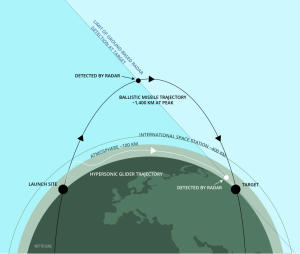
Photo Courtesy of Project Ploughshares (2021)
Hypersonics, a True Game Changer-What is the Military Value of Hypersonic Weapons?
Key Points
- Hypersonic weapons are specifically designed for increased survivability against modern ballistic missile defense systems
- Speed
- Hypersonics, Reach Speeds of Up to Mach 27, this is Too Fast to Counter
- Altitude
- Hypersonics, Too High for Anti-aircraft Batteries, Too Low for Anti-Ballistics Defenses
- The general term of “hypersonic weapons” here refers to aircraft, missiles (other than ballistic missiles), rockets, and spacecraft that can reach speeds through the atmosphere faster than Mach 5, that is, nearly 4,000 miles per hour
- Unlike ballistic missiles, hypersonic weapons are designed to remain within Earth’s atmosphere, traveling at speeds of up to Mach 27
- By staying in the atmosphere, they evade both anti-ballistic missile defenses and traditional, anti-aircraft missile defenses, since they fly too low for the first and too high for the second
- Thus, hypersonics appear to be a true game-changer technology, as they strongly amplify the attributes of air power (speed, range, flexibility and precision), and as they offer the potential for military operations from longer ranges with shorter response times and enhanced effectiveness compared to current military systems
- Conventional ballistic missiles remain highly visible on radar and fly in a predictable trajectory, making them susceptible to advanced missile defense systems. That is why today’s active research and development mostly focus on the progress that can be made regarding hypersonic flight, from materials to withstand high temperatures generated in the atmosphere, to more efficient propulsion systems, size, weight, power, guidance, communications, and other harsh-environment applications (FINABEL-European Army Interoperability Centre, 2020) (Defense-Aerospace.com, 2019)
Are Hypersonic Weapons All they are Chalked Up to Be?
- An expert scientist by the name of Dr. Cameron Tracy, who is part of the Union of Concerned Scientists, argues that the precision and overall utilities of hypersonic missiles are often overestimated
- Dr. Tracy points out that flying through the atmosphere exposes the missile to heat which may degrade the surface of the missile, thereby affecting its flight path
- Secondly, the missile is exposed to wind, as well as varying levels of air density
- Finally, the heat around the missile risks creating a plasma that intercepts the missile’s ability to receive guidance from satellites or other sources
- Tracy earlier, had argued that satellite warning systems can detect hypersonic missiles in the same way as they would detect ballistic missiles
- As such, Dr. Tracy concludes that hypersonic missiles do not offer a decisive advantage compared to established technologies like ballistic missiles
- Despite the criticisms and challenges, multiple countries are determined to acquire and develop hypersonic technologies in the upcoming decade
- Consequently, the technology could give rise to a new arms race on a global scale (FINABEL-European Army Interoperability Centre, 2020)
What are the Dangers of Hypersonic Technology?
Key Points
- Warhead Ambiguity
- Arms Escalation & Instability
- Hypersonic military systems can deliver conventional or nuclear payloads. Thus, hypersonic weapons are characterized by “warhead ambiguity.” This means that it is not clear to adversaries if the weapons are nuclear-armed or armed with conventional payloads. In such a situation, the tendency is for adversaries to assume that the weapons are nuclear-armed. Combined with minimal reaction time afforded by hypersonic missiles, in the event that one is launched, a nuclear-armed adversary might well assume that it is under nuclear attack and respond accordingly. The result could be nuclear war, even if unintended
- Hypersonic weapons are contributing to an emerging arms race that extends beyond the missiles themselves. Intended to outpace existing anti-ballistic missile defense systems currently operated by states such as United States, Russia, Israel, and India, their development encourages the acceleration of new defense capabilities, potentially spurring a security dilemma and causing further arms escalation and instability
- Gaining dominance in the application of offensive hypersonic weapons capability could have significant geopolitical consequences, creating a power imbalance, the like of which was not seen in the Cold War. Guaranteed first strike capability would upend current nuclear deterrence strategies and surely heighten international instability (Project Ploughshares, 2021)
The Roles and Utility of Hypersonic Weapons
- Hypersonic weapons are intended to provide an asymmetric advantage, and could provide a significant qualitative enhancement to theatre and strategic strike capabilities (Defense iQ, 2020)
- Hypersonics through their speed and maneuverability offer a number of advantages, in particular, with regard to the prosecution of time critical targets, where the additional speed of a hypersonic weapon is valuable, or against heavily defended targets
- Hypersonics will reduce the time required to prosecute a target, the warning time available to an adversary, and the time available for defensive systems to engage the incoming threat
- In the conventional precision strike role, hypersonic systems will require a robust supporting intelligence, surveillance, target acquisition and reconnaissance capability, in particular to prosecute mobile/re-locatable targets (Defense iQ, 2020)
Why does the USA Need Hypersonics?
- Joint Chiefs of Staff and former Commander of U.S. Strategic Command General John Hyten has stated, these weapons could enable “responsive, long-range, strike options against distant, defended, and/or time-critical threats [such as road-mobile missiles] when other forces are unavailable, denied access, or not preferred.” Critics, on the other hand, contend that hypersonic weapons lack defined mission requirements, contribute little to U.S. military capability, and are unnecessary for deterrence
Has the US Department of Defense Given a Green Light to Hypersonic Weapons?
This is a Good Question….Nothing has been formalized…Yes and No is the best answer
No
- At present, the Department of Defense (DOD) has not established any programs of record for hypersonic weapons, suggesting that it may not have approved either requirements for the systems or long-term funding plans
- Indeed DOD has not yet made a decision to acquire hypersonic weapons and is instead developing prototypes to assist in the evaluation of potential weapon system concepts and mission sets
Yes
- The Pentagon’s FY2021 budget request for all hypersonic-related research is $3.2 billion—up from $2.6 billion in the FY2020 request—including $206.8 million for hypersonic defense programs
- This is a strong indicator that the US will be moving forward with Hypersonics (Forbes, 2020)
What about the US Department of Defense and Hypersonic Defense Systems?

Photo Courtesy of Tesmanian (2020)
Elon Musk and SpaceX-Missile Defense-Based on Starlink Satellite Constellations
- The Verge reported in October of 2020 that, SpaceX received a contract worth more than $149 million from the Space Development Agency (SDA), tasking the company with building a new satellite for the US military capable of tracking and providing early warnings of hypersonic missile launches. Another company, L3Harris Technologies out of Florida, was given more than $193 million by the agency to also build tracking satellites
- The satellites are meant to be the first crucial part of the SDA’s Tracking Layer Tranche 0, which is designed to provide missile tracking for the Defense Department from space using infrared sensors
- SpaceX and L3Harris will together build eight satellites to deliver to the DOD for the Tracking Layer — the first satellites in a planned constellation designed to provide missile tracking from space using infrared sensors
- The Tracking Layer will work in partnership with the SDA’s proposed Transport Layer, another planned constellation of between 300 and 500 satellites that will provide “low-latency military data and connectivity worldwide” to military assets (The Verge, 2020)
Are Hypersonic Weapons a New Arms Race?
- When one sums up all the countries that are investing heavily in research and development of Hypersonic Delivery Technology or have already deployed hypersonics to arsenals, there is little argument that hypersonics are not playing an important role in a strategic arms race
De Faakto Intelligence Forecast Analysis
- De Faakto research indicates that the driver to develop and field hypersonic vehicles, is ultimately for the delivery of nuclear warheads; this denotes & confirms a new type of arms race
- Because hypersonics can not be countered at this time, one hypothesis is that first strike capability using hypersonics will be a defense that will provide deterrence until countermeasures are developed and fielded
- Alternatively to first strike capability, the best deterrent at this time is numbers; the nation able to field the most hypersonic weapons will have the advantage
- Open source information denotes lasers and rail guns will have a role to play in destroying hypersonic vehicles
DARPA on Hypersonic Counter Measures
- DARPA states that “a key figure of merit is deterrence: the ability to create large uncertainty for the adversary’s projected probability of mission success and effective raid size”
- Anti-hypersonic defense is successful not by necessarily destroying every incoming boost-glide vehicle, but by making a potential adversary uncertain of which hypersonic vehicles will get through (The Fanatical Futurist, 2020)
RAND Corp. Think Tank on Hypersonic Counter Measures
- George Nacouzi, an engineer at RAND believes there are ways to shoot down Hypersonic Glide Vehicles, “but they would involve using a nearly ubiquitous surveillance and tracking system accompanied by strategically positioned very high performance interceptors or, possibly in the future, directed energy weapons.” The U.S. is developing these solutions for intercepting ballistic missiles, but they all have drawbacks: directed energy weapons such as lasers can be affected by weather, while having armed drones or aircraft constantly hovering over North Korean missile sites could trigger a war (The Fanatical Futurist, 2020)
Lockheed Martin on Hypersonic Counter Measures
- Lockheed Martin, a leader in missile defense technology, says that existing systems for intercepting ballistic threats can be evolved to cope with hypersonic attacks, but the money to do so hasn’t been budgeted, and the sensor constellation needed to track such threats hasn’t progressed much beyond the PowerPoint stage. Michael Griffin, the Pentagon’s top technologist, figures the U.S. won’t be deploying a “counter-hypersonic” defense anytime before the mid-2020s. By then, hypersonic weapons could be everywhere on the modern battlefield (Forbes, 2019)
Carnegie Endowment for International Peace on Hypersonic Counter Measures
- James Acton, an arms control expert at the Carnegie Endowment for International Peace, argues that despite their speed, hypersonic weapons can be destroyed by some ballistic missile defense systems such as the Terminal High Altitude Area Defense (THAAD) system. The problem is that THAAD is a point-defense weapon designed to protect a small area: covering the entire United States with THAAD-like defenses would be prohibitively expensive (The Fanatical Futurist, 2020)
Hypersonic Ordinance as a Deterrent, North Korea
- North Korea has managed to develop nuclear warheads and has rocket making expertise
- Kim Jong-un’s Hermit state is considered a regional & international security risk, hypersonic vehicles will allow adversaries to strike North Koreas nuclear arsenal, and neutralize its strong conventional forces at the outset of an engagement
- De Faakto analysis projects it will be some time before North Korea can develop and field hypersonic weapons without assistance from Russia or China
- It would be difficult to rule out the possibility of an ideologically allied nation sharing hypersonic technology with North Korea
Countries that Have Acquired, or Claim to Have Acquired Hypersonic Capable Weapons
Russia, China
- Open-source reporting denotes that both China and Russia have conducted numerous successful tests of hypersonic glide vehicles, and both are expected to field an operational capability as early as 2020 (Congressional Research Service, 2020)
- De Faakto research finds that Russia has already deployed operational hypersonic weapons in districts of its territory
Who are the Other Hypersonic Players on the International Stage?
United States of America
Lockheed Martin AGM-183A Test: US HYPERSONIC MISSILE-Courtesy of Giancarlo Casem & Chris Okula
- The US has so much invested in Hypersonic Vehicles and technology development and research, it would be difficult at this time to disprove the US could not or will not field hypersonic weaponry imminently
- Evidence lies in the extent of how many branches of the US military are deep into hypersonic development
- At the time of this analysis & research, the United States Air force Air Force Life Cycle Management Center’s Armament Directorate at Eglin Air Force Base in Florida, is testing the hypersonic Lockheed Martin AGM-183A weapon
- The AGM-183A consists of a nose section holding an unpowered boost-glide vehicle attached to a large rocket booster. The rocket brings the vehicle to the optimal speed and altitude, after which it glides along a relatively level flight trajectory at hypersonic speed (The Drive-Warzone, 2021)
France
What is France Doing with Hypersonics?
- “We could not wait anymore” French Armed Forces Minister Florence Parly
- “Many nations are procuring such weapons, and we have all the necessary skills to develop one: we could not wait,” three of the five permanent members of the UN Security Council are already engaging in a new arms race for this kind of weapon: China, Russia and the United States (Defense-Aerospace.com, 2019)
- France has awarded ArianeGroup a contract to develop a hypersonic glider technology demonstrator that is due to make its first flight by the end of 2021, according to Armed Forces Minister Florence Parly
- The hypersonic glider demonstrator, will be able to reach a speed of over Mach 5 (over 6,000 km/h)
- France is already conducting studies on hypersonic propulsion as part of the modernization of its nuclear deterrent
- The French hypersonic demonstrator is designated V-Max, (Véhicule Manoeuvrant Expérimental)
- The V-Max will be about 2 meters long, with a hyper fast system capable of hypermaneuvrability (Defense-Aerospace.com, 2019)
United Kingdom
- In July 2019, Air Vice Marshal Simon Rochelle, then Chief of Staff Capability, announced at the Chief of the Air Staff’s Air and Space Power Conference that the UK sought to deploy a hypersonic weapon by 2023
- Given the cost of developing a hypersonic weapon system, it is likely that any UK capability will either be an off-the-shelf acquisition or a collaborative venture, either with European partners or with the United States (Defense iQ, 2020)
Australia
- Australia will jointly develop hypersonic cruise missiles with the United States in a bid to counter China and Russia which are developing similar weapons, according to Defense Minister Linda Reynolds
- “We will continue to invest in advanced capabilities to give the Australian Defense Force more options to deter aggression against Australia’s interests”
- Australia had set aside up to 9.3 billion Australian dollars ($6.8 billion) this year for high-speed, long-range missile defense systems, including hypersonic research (Defense News, 2020)
- China has deployed, or is close to deploying, hypersonic systems armed with conventional warheads, according to defense analysts
- Australia said in July it would boost defense spending by 40% over the next 10 years to acquire longer-range strike capabilities across air, sea and land. The move comes as Canberra broadens its military focus from the Pacific to the Indo-Pacific region (CNN, 2020)
Japan
Scramjet Technology
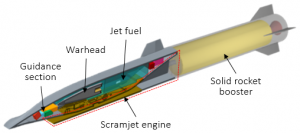
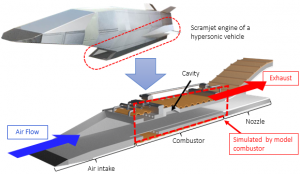
Photos Courtesy of Ministry of Defense Japan Acquisition Technology Logistics Agency (2021)
- Japan is acquiring both scramjet (Hypersonic Cruise Missile), and boost-glide weapons (Hyper Velocity Gliding Projectile) (CNN, 2020)
- The hypersonic guided missile is ground-launched, but under current plans, the Japan Air Self-Defense Force (JASDF) will deploy three different types of modern anti-ship missiles, the Joint Strike Missile (JSM) for the F-35, the Long Range Anti-Ship Missile (LRASM) for the modernized F-15J/DJ fleet, and the extended-range ASM-3 for the F-2 (NavalNews.com, 2020)
The Japanese Hybrid, Ramjet + Scramjet propulsion
- The scramjet engine is expected to have high engine efficiency in a wide range of speeds, from Mach 5 to 15, because the air inhaled from the intake is compressed and combusted at supersonic speed when the missile flying at Mach 5 or higher
- That means that the scramjet engine would need to be accelerated to hypersonic speeds to operate, and that would require acceleration by a rocket booster, which would increase the overall length of the missile, including the booster
- Therefore, ATLA planned to combine the capabilities of the ramjet engine, which operates efficiently in the Mach 3 to 5 speed range (supersonic speed), with the scramjet engine (DMSJ) to reduce the proportion of the rocket booster
- In this way, the rocket booster only needs to accelerate the missile to supersonic speed, and from there, the ramjet engine accelerates the missile to hypersonic speed, which then activates the scramjet engine to cruise (NavalNews.com, 2020)
Japan & Hypersonic Defense
- It is notable that the Japanese government is explicitly considering a constellation of low-orbiting satellites to identify and track hypersonic missiles that travel at lower altitudes than ballistic missiles on irregular trajectories
United Arab Emirates
MDBA Light & Heavy Smart Glider


Photos Courtesy of MBDA (2021)
- Pan-European missile systems manufacturer MBDA signed a head of terms agreement with the United Arab Emirates’ (UAE’s) Tawazun to develop the SmartGlider family of guided weapons
- The system is in a pre-development concept phase, with the new agreement to begin the development of the system from design to production phase
- Under the agreement, a joint team of engineers from both organizations will begin development of the missile system. The majority of the engineers will be from Tawazun and will undertake work through MBDA’s first regional Missile Engineering Centre established in UAE (Janes Information, 2021)
Israel

Photo Courtesy of aNEWS (2021) -USA Collaboration Arrow-4 Ballistic Defense Missile-The Arrow 4 will serve as a prototype for future Hypersonic design
- Israel has expressed interest in developing hypersonics, and already has some hypersonic technology in the form of the Arrow Ballistic Missile defense
- Israel will likely work closely with the US department of defense to develop a joint hypersonic or purchase hypersonic vehicle technology from the United States
India
- India test fired its first hypersonic missile demonstrator in September of 2020
- India’s indigenous Hypersonic Technology Demonstrator Vehicle (HSTDV) should prove technologies which can be incorporated into next generation weapons
- The HSTDV test vehicle has been developed by DRDO (Defence Research and Development Organisation)
- DRDO is known to be working on a hypersonic anti-ship missile known as BrahMos-II
- This will succeed the Indian Navy’s BrahMos anti-ship missile, which is already supersonic at Mach 3
- Jointly developed with Russia, it is based on the P-800 Oniks missile and uses a ramjet to reach its high cruising speeds (Forbes, 2020)
- The test comes amid heightened tensions with China & the maritime domain where the rapid expansion of the Chinese Navy may soon reach into the Indian Ocean (ScienceMag.org, 2020)
- China will soon have at least three aircraft carriers and a host of large destroyers, frigates and submarines. While China is not reported to have a hypersonic anti-ship missile, it has a number of sophisticated weapons projects. Many of its warships carry high performance anti-ship missiles. And they are complemented by anti-ship ballistic missiles which present their own challenges in defending against (Forbes, 2020)
- India’s hypersonic anti-ship missiles will give Chinese Navy planners a headache
- In some respects hypersonics are the counter to China’s increasingly potent naval fleet (Forbes, 2020)
Russian Indian Hypersonic Collaboration, Zircon & BrahMos II
- The benchmark hypersonic anti-ship missile is the Russian 3M22 Zircon, and is now aboard Russian warships and submarines
- BrahMos-II, which is a joint Indian-Russia project appears to be very similar to Zircon and is possibly related (Forbes, 2020)
Russia

Photo Courtesy of OIDA Group (2018)
Kh-47M2 Kinzhal –“dagger” air-launched ballistic missile [OPERATIONAL]
- Russia recently unveiled a weapon called the Kinzhal, said to reach Mach 10 under its own power, and another that is boosted by a rocket to an astonishing Mach 27 (ScienceMag.org, 2020)
- The Kinzhal entered service in December 2017
- The dagger, is a Russian nuclear-capable air-launched ballistic missile
- The claimed range is more than 2,000 km (1,200 mi), Mach 10 speed, and an ability to perform evasive maneuvers at every stage of its flight
- It can carry both conventional and nuclear warheads and can be launched from Tu-22M3 bombers or MiG-31K interceptors
- It has been deployed at airbases in Russia’s Southern Military District
Avangard-Hypersonic Glide Vehicle
- In 2016, Russia is believed to have conducted two successful tests of Avangard, a hypersonic glide vehicle
- The third known test, in 2017, failed
- In 2018, an Avangard was launched at the Dombarovskiy missile base, reaching its target at the Kura shooting range, a distance of 3700 miles
- The Avangard, previously known as Objekt 4202, Yu-71 and Yu-74 is a Russian hypersonic glide vehicle (HGV) that can be carried by heavy ICBMs, which can deliver both nuclear and conventional payloads
3M22 Zircon-Scramjet
- The Zircon is a scramjet powered maneuvering anti-ship hypersonic cruise missile currently being tested by Russia (ScienceMag.org, 2020)
- The Zircon is also known as the 3M22 Tsirkon
- NATO designation for Zircon is SS-N-33
China
- Beijing is making a major investment in hypersonic missiles. China’s military leadership see this technology as an important element of its regional war fighting strategy and possibly its strategic deterrent. China possesses one operational hypersonic missile, has tested several others, and maintains an active research and development program. While China’s specific plans for fielding such systems are unclear, it is possible to identify potential strategic and operational issues that will need to be addressed as its capabilities mature (Georgetown Journal of International Affairs, 2021)
- Beijing is testing hypersonic glide vehicles, this element of a robust missile program that has led to the fielding of numerous medium- and intermediate-range ballistic and cruise missiles in support of China’s regional war fighting capability
- In 2019 China launched “…more ballistic missiles for testing and training than the rest of the world combined.” Unconstrained by treaty limits to which the United States adhered for decades, the People’s Liberation Army (PLA) has fielded a diverse family of missiles that it believes will create operational advantage in a future military confrontation
DF-17
- China has successfully tested the DF-17, a road-mobile medium-range ballistic missile (MRBM) designed to launch a Hypersonic Glide Vehicle (HGV) with a range of 1,800-2,500 kilometres
- The accompanying HGV, designated as DF-ZF (previously WU-14), is reported to possess a range of 1,600-2,400 kilometers and can achieve speeds of Mach 5 – Mach 10 with high degrees of manoeuvrability and accuracy (Missile Defense Advocacy, 2019)
- Some reports suggest that China is also considering deploying HGVs on DF-21 and DF-26 theatre-range ballistic missiles
Starry Sky-2 (Xingkong-2)
- China reportedly conducted successful tests of the Starry Sky-2 (Xingkong-2) hypersonic cruise missile in 2018. This system, believed to have a range of 700-800km and a top speed of Mach 6, appears to make use of an experimental “waverider” design that uses powered flight after launch and creates shockwaves to sustain its lift. In its test phase, the Starry Sky-2 vehicle was sent into space by a multi-stage rocket before separating from its booster for maneuvered flight back to Earth. Some analysts have suggested that this technology could emerge in the mid-2020s as an advanced anti-ship missile
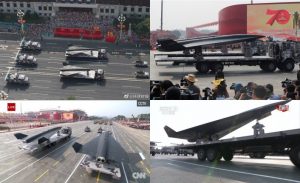
Images are reported to be the PLAs WZ-8 Intelligence Surveillance Reconnaissance Hypersonic Drone
Photo Courtesy of The Aviationist (2019)
- In 2015 China reportedly successfully tested a hypersonic unmanned aerial vehicle (UAV), presumably as a future intelligence, surveillance and reconnaissance (ISR) platform. Whether this emerging family of hypersonic vehicles will perform “as advertised” by Chinese government agencies remains to be seen. Arguments that characterize these developments as inherently “game changing” should be assessed cautiously (Georgetown Journal of International Affairs, 2021)
![]()
Resources
War at the Speed of Light-Potomac Books-Louis A. Del Monte (2021)
Hypersonic Weapons: Background and Issues for Congress-Government of the United States of America- Kelley M. Sayler (2020) https://fas.org/sgp/crs/weapons/R45811.pdf
National pride is at stake- Russia, China, United States race to build hypersonic weapons-Science Mag.Org-Richard Stone (2020) https://www.sciencemag.org/news/2020/01/national-pride-stake-russia-china-united-states-race-build-hypersonic-weapons
India Goes Hypersonic: New Missile Technology May Be Answer To China’s Navy-Forbes-H.I. Sutton (2020) https://www.forbes.com/sites/hisutton/2020/09/08/india-goes-hypersonic-new-missile-technology-may-be-answer-to-chinas-navy/?sh=35657568d937
France to Flight-Test Hypersonic Demonstrator by 2021-Defense-Aerospace.com (2019)https://www.defense-aerospace.com/articles-view/release/3/199420/france-to-develop-hypersonic-missile-demonstrator.html
Hypersonic missiles and European security: Challenges ahead-FINABEL-Audrey Quintin & Robin Vanholme (2020)https://finabel.org/hypersonic-missiles-and-european-security/
Options for a UK Hypersonic Weapons Capability-Defence iQ-James Bosbotinis (2020) https://www.defenceiq.com/air-land-and-sea-defence-services/articles/options-for-a-uk-hypersonic-weapons-capability
Australia partners with US to develop hypersonic missiles-Reuters-VIA CNN (2020) https://www.cnn.com/2020/12/01/australia/hypersonic-missile-australia-us-intl-hnk/index.html
Australia, US partner on air-launched hypersonic missile-Defense News-Nigel Pittaway (2020) https://www.defensenews.com/industry/techwatch/2020/11/30/australia-us-partner-on-air-launched-hypersonic-missile/
Japan’s ATLA Developing Hypersonic Anti-Ship Missile-Naval News-Yoshihiro Inaba (2020) https://www.navalnews.com/naval-news/2020/04/japans-atla-developing-hypersonic-anti-ship-missile/
Japan’s Vice Defense Minister leaks image of new hypersonic anti-ship missile-Navy Recognition (2020) https://www.navyrecognition.com/index.php/news/defence-news/2020/july/8718-japan-s-vice-defense-minister-leaks-image-of-new-hypersonic-anti-ship-missile.html
The risks of hypersonic weapons-Project Ploughshares-Mark McWhinney (2020) https://ploughshares.ca/pl_publications/the-risks-of-hypersonic-weapons/
China’s Hypersonic Weapons-Georgetown Journal of International Affairs-Paul Bernstein and Dain Hancock (2021) https://gjia.georgetown.edu/2021/01/27/chinas-hypersonic-weapons/
DF-ZF Hypersonic Glide Vehicle-Missile Defense Advocacy (2019) https://missiledefenseadvocacy.org/missile-threat-and-proliferation/todays-missile-threat/china/df-zf-hypersonic-glide-vehicle/
IDEX 2021: MBDA, Tawazun sign agreement on SmartGlider development-Jane’s Defence-Charles Forrester (2021) https://www.janes.com/defence-news/news-detail/idex-2021-mbda-tawazun-sign-agreement-on-smartglider-development
The Air Force Says Its First Hypersonic Missile Will Make Its Inaugural Flight Within 30 Days-The Drive The Warzone-JOSEPH TREVITHICK (2021) https://www.thedrive.com/the-war-zone/39634/agm-183-hypersonic-missile-to-make-first-flight-within-30-days-according-to-air-force
DARPA announces “Counter-Hypersonics” program to counter the catastrophic threat from hypersonic weapons-Fanatical Futurist-Matthew Griffin (2020) https://www.fanaticalfuturist.com/2020/03/darpa-announces-counter-hypersonics-program-to-counter-the-catastrophic-threat-from-hypersonic-weapons/
Defense Against Hypersonic Attack Is Becoming The Biggest Military Challenge Of The Trump Era-Forbes-Loren Thompson (2019) https://www.forbes.com/sites/lorenthompson/2019/07/30/defense-against-hypersonic-attack-is-becoming-the-biggest-military-challenge-of-the-trump-era/?sh=409acf9e62c0
The Pentagon used a hypersonic bullet to shoot down a mock cruise missile for the first time-Task & Purpose-Jared Keller (2021) https://taskandpurpose.com/news/air-force-hypervelocity-projectile-test/
SpaceX receives contract to build missile tracking satellites for the Defense Department-The Verge-Loren Grush (2020) https://www.theverge.com/2020/10/6/21503165/spacex-space-development-agency-contract-missile-warning-satellites-starlink
Why Hypersonic Missiles Are Changing the Defense Landscape-Nippon.com-Nose Nobuyuki (2020) https://www.nippon.com/en/in-depth/d00613/
Images
Photo Courtesy of Chinese Journal of Aeronautics (2018) https://www.sciencedirect.com/science/article/pii/S1000936118302073
Photo Courtesy of Project Ploughshares (2020) https://ploughshares.ca/pl_publications/the-risks-of-hypersonic-weapons/
Photo Courtesy of Tesmanian (2020) https://www.tesmanian.com/blogs/tesmanian-blog/spacex-starlink-satellite-internet-may-launch-in-germany-this-year
Photo Courtesy of Japan Ministry of Defense-Acquisition, Technology & Logistics Agency (ATLA) (2021) https://www.mod.go.jp/atla/en/kousouken.html
Photo Courtesy of MDBA Missile Systems (2021) https://www.mbda-systems.com/product/smartglider/
Photo Courtesy of aNEWS (2021) https://www.anews.com.tr/middle-east/2021/02/18/israel-us-developing-new-arrow-4-ballistic-missile-shield
Photo Courtesy of OIDA Strategic Intelligence (2019) https://oidagroup.com/russia-on-the-path-to-hypersonic-war/
Photo Courtesy The Aviationist (2019) https://theaviationist.com/2019/10/01/china-unveils-a-new-supersonic-spy-drone-during-massive-military-parade-in-beijing-and-heres-our-analysis/

![]()
Intelligence Research Observatory
Editing Services Provided by M. (Sissy) Castulovich & Chuck Stevens






